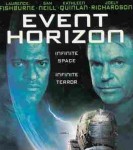One of the most recurrent motives throughout ‘Event Horizon’ is that of cigarettes and smoking. Set in a distant future world with heightened technology, nevertheless the cigarette still appeals as a basic human necessity, grounding all the developments of technology in a firmly human mentality, that of needing ‘a quick gasper.’ After Smitty successfully navigates the ship through turbulence to bring the Lewis & Clark opposite the Event Horizon, Fishburne’s character tells him “If you’ve got ‘em, smoke ‘em,’ at which point he duly does so.
 The use of the cigarette has several functions. Apart from allowing the camera to track round the various crewmembers as it follows the passage of the cigarette from hand to hand, it contrasts feelings of ease with those of tension. DJ casually removes his cigarette to inject Dr. Weir in preparation for the gravity-tank, which contrasts with Weir’s apprehension as he admits suffering from claustrophobia. Smitty smokes as a relaxation after fighting to bring the ship through turbulence, but his smoking also betrays his nervousness on hearing the real reason for the mission in Weir’s briefing. It also forms part of DJ’s own character, combining with his reticence and underlying tension, to portray an individual on the verge of a breakdown.
The use of the cigarette has several functions. Apart from allowing the camera to track round the various crewmembers as it follows the passage of the cigarette from hand to hand, it contrasts feelings of ease with those of tension. DJ casually removes his cigarette to inject Dr. Weir in preparation for the gravity-tank, which contrasts with Weir’s apprehension as he admits suffering from claustrophobia. Smitty smokes as a relaxation after fighting to bring the ship through turbulence, but his smoking also betrays his nervousness on hearing the real reason for the mission in Weir’s briefing. It also forms part of DJ’s own character, combining with his reticence and underlying tension, to portray an individual on the verge of a breakdown.
The secondary function of the cigarette is to create contrast with the surrounding advanced technological environment. In an age when interstellar space-travel has apparently led to the construction of vast ships, gateway-opening gravity propulsion systems (the language Weir uses to describe its function is dazzling, impenetrable and certainly confusing), with advanced computer software and medical facilities, people still continue to rely on old-fashioned nicotine in paper wrappings. The constant visual reference to cigarettes grounds the almost bewildering world of technology in a tangible plane, to which most viewers will relate. The fragility of the rolled cigarette clashes with the heavily metallicised world in which the crew are accustomed to living and working, emphasized by a shot of the comparative sizes of the rescue vessel, tenuously clasping onto the ‘Event Horizon’ itself, which dwarfs her completely.
There’s a wonderful shot in Aliens, where the camera tracks up an elegant hand holding a cigarette: subsequently revealed to be Ripley’s, it looks rather like the skeletal hand of one of the alien monsters themselves – a brief but neat ambiguity.
In space, no-one can hear you smoke.
Posted by Daniel Harding, Deputy Director of Music at the University of Kent. Click here to view his Music Matters blog.

